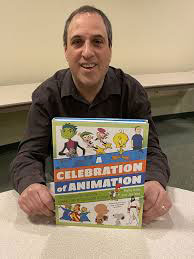Author, Pop-Culture Enthusiast Explores the Evolution of Rock ‘n’ Roll
News Based on facts, either observed and verified directly by the reporter, or reported and verified from knowledgeable sources.
By Jordan Goodman

Marty Gitlin is a nonfiction author and former sports journalist. He also wrote books for high school students about pivotal events in American history such as Brown v. Board of Education, biographies and the evolution of viral cultural mediums like contemporary animation.
Now, Gitlin is taking his historical expertise and enthusiasm to libraries and senior centers across the tristate area to talk about rock ‘n’ roll, its origins and the pioneers who birthed it.
Last Saturday afternoon, Gitlin spoke at the North Castle Public Library in Armonk about the earliest trailblazers of the genre, the smash hits and performances that put rock on the map and its cultural significance on society. The event included a PowerPoint presentation of historical events, clips of the greats who helped transform rock’s evolving early sound, trivia questions for the audience and a Q&A.
Gitlin’s passion in exploring early rock ‘n’ roll didn’t materialize until he was 16. But by the time he entered Ohio University, he was fascinated by each boundary pusher he came across, a good distraction from the mainstream radio hits of the day, which at the time was mostly disco.
Gitlin said it’s not really known exactly where rock originated. As early as 1954 there was Bill Haley’s “Rock Around the Clock,” but most early rock shared similarities with popular 1920s music, specifically R&B, blues and soul.
Even before then, in the 1940s, he pointed to a clip of a seven-year-old Sugar Chile Robinson playing the blues on the piano in an unconventional style.
But rock started as a genre made by young adults and teens that catered to their peers, Gitlin said.
Its advent was initially alarming and frightening to parents of young children and many community leaders, sometimes associating the sound with “Black genres,” he said. The backlash was unavoidable. But Gitlin said Black artists were some of the most influential performers in expanding rock’s evolving sound in the 1950s.
“Ask any musical historian the most talented artist of that era, they’d probably say Chuck Berry because of his stage presence and tremendous guitar playing,” Gitlin said. “He was a great entertainer with the way he moved on stage.”
His performance of the classic “Johnny B. Goode” showed Berry moving with the music, which helped to popularize dances like the Pony and the Mashed Potato. This marked a key shift, not just with sounds and artists evolving, but with the performers, entertainers, dances and fads helping mark rock’s presence in society.
Berry’s influence expanded into the early to mid-1960s, as many of the guitar and vocal techniques that he helped pioneer inspired new artists. Even the earlier “outlandish” performances introduced ways of performing that were unconventional, but incredibly memorable and inspirational. In Little Richard’s performance of “Lucille,” you can hear him squealing the lyrics to raise the energy level in the room and banging his hands on the keys with one leg on top of the piano.
By that time, rock had become a visual genre, Gitlin said. Berry, Elvis Presley and Bo Diddly all mastered the performative nature of rock ‘n’ roll.
Speaking of Elvis, during his 1950s heyday he was the second most popular selling artist of the time, not just through the music but with how he connected with audiences. He was a superstar with an instantaneously recognizable presence. The October 1956 Ed Sullivan Show performance of “Hound Dog” meant that rock had hit a new level of popularity. Its practitioners would develop a deep connection with younger audiences, as shown in the clip of the performance. Presley’s singing is instantaneously drowned out by the collective screams of fangirls.
While the younger generations of fans helped shift rock’s popularity to the mainstream, its biggest critics made it seem like the teens were losing control, Gitlin said.
The birth of superstars also gave rise to the early emergence of popular rock groups, with Gitlin citing works by The Coasters and the Del-Vikings. He showed a clip of The Coasters’ hit “Charlie Brown,” which offered a visual element to rock’s sound, almost as if each member was acting out the cartoonish and tongue-in-cheek lyrics.
In Buddy Holly and the Crickets’ performance of “Peggy Sue,” the camaraderie between the artists and the shared youthful energy within their music made it a greater attraction to audiences.
Gitlin concluded with a brief Q&A with the audience, which included discussion about the convergence of different audience demographics within rock’s evolution, historical events such as “the day the music died” and what he thinks today’s performers can learn from the pioneers.
“Our tastes can either evolve or devolve, but we must remember the great performers and artists that solidified rock ‘n’ roll’s place within music culture,” Gitlin said.

Examiner Media – Keeping you informed with professionally-reported local news, features, and sports coverage.
